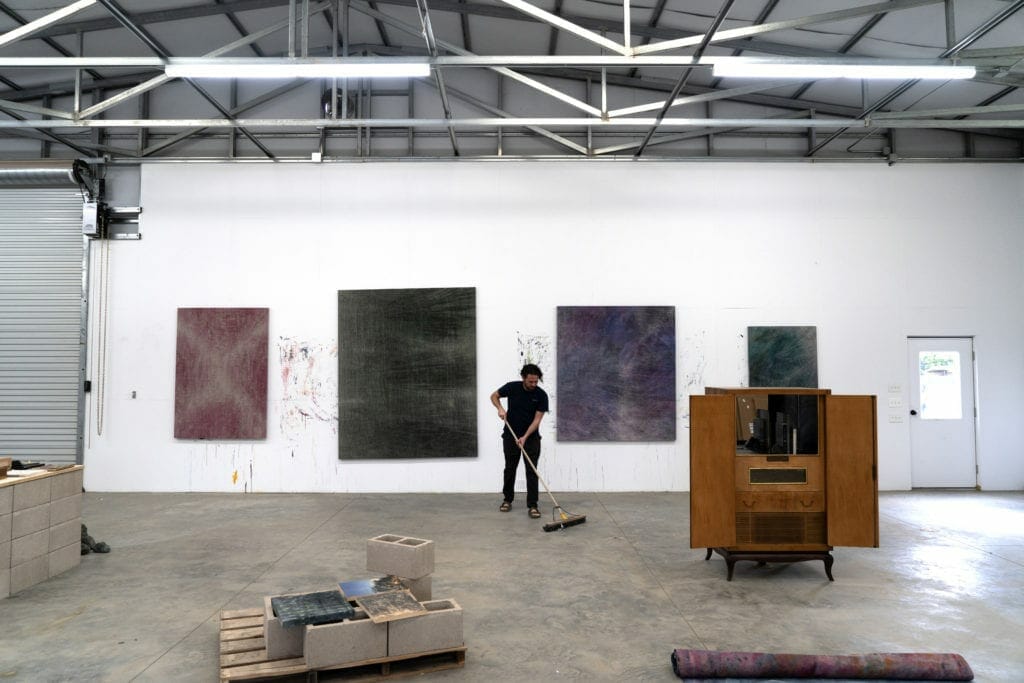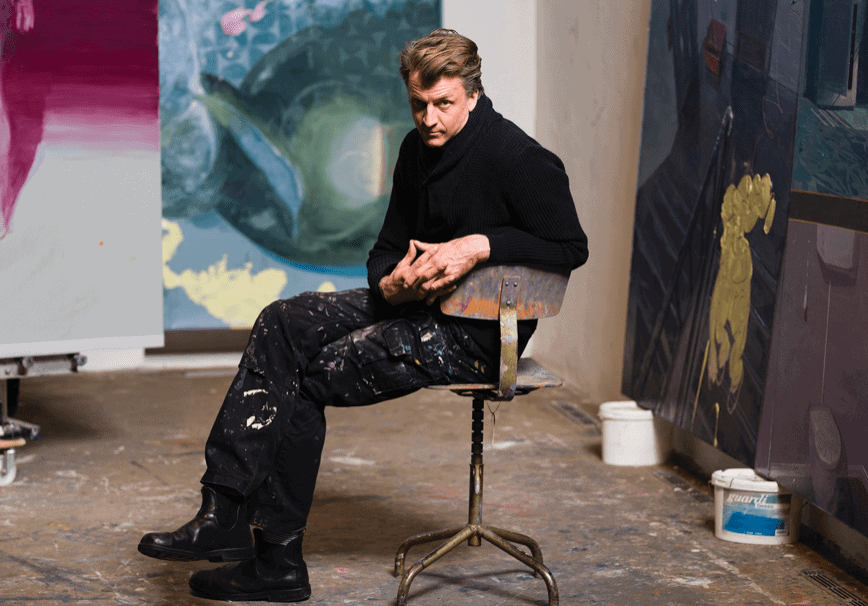
Mark-Making: 5 Abstract Painters You Need To Know
Trends in Contemporary Art
One of emerging artists‘ most frequently asked questions is how to get discovered or increase your chances of getting discovered. We often hear exhilarating stories of sudden international recognition—think of Carmen Herrera‘s (1915-2022) late-life discovery aged 89 or the postmortem discoveries of Hilma Af Klint (1862-1944) and Vincent Van Gogh (1853-1890).
Although these stories are inspiring and give hope to all unknown artists that they might be discovered in the future, they also paint a delusional picture of the path to success for artists, from zero to hero, rags to riches, or from a small home studio to a retrospective exhibition at the Museum of Modern Art. In reality, being ‘discovered’ does not work this way.
The stories of the artists mentioned above are exceptions to the rule. And even more, Carmen Herrera had numerous institutional shows before being ‘discovered’ by top-tier art galleries and renowned curators—indicating her discovery was more gradual than seen from the outside. The truth is being discovered as an artist is, in >99% of the cases, a process of hard work encompassing several years. Even contemporary artists’ most explosive success stories today took around ten years to become established artists.
But do not despair because small discoveries can be as great as a victory for artists today. Think of your first exhibition at an art gallery, an invitation by an influential curator to participate in an institutional exhibition, or being selected as a finalist in a renowned art contest. So, how do we get discovered?
First, in this article, we won’t share the obvious ingredients for success or to get discovered, such as creating original art and standing out. [If you do want to read more on how to become a successful artist in general, how to make sure to read our extensive article on this topic here.] Let’s say your work has what it takes. How do we proceed from here on?
When it comes to being discovered as an artist, I often come across false information online advocating to gain maximum exposure to increase your chances of getting discovered. The truth is, however, it is not about obtaining maximum exposure but the correct exposure. In the art world, numerous unwritten rules regarding an artist’s expected behavior exist. As a result, to have a chance of being picked up by a gallery director or curator, there are as many things you need to avoid as there as things you have to do to gain the correct exposure.
For instance, if you would buy a national TV commercial for your art, your exposure would be tremendous, and it could probably generate some sales as well. But to go forward as an artist, the commercial will have a negative impact because it is too commercial, not-done, and frowned upon in the art world.
Therefore, this article discusses four specific actions to do and four actions you must avoid at all times to gain the correct exposure in the art world, increasing your chances of being discovered.
Social media is a terrific way to network organically, link up with various actors, and build a following for your art. Of all social media platforms, Instagram is, without any doubt, the most powerful for artists. You would be surprised how many collectors and gallery directors use the Instagram browse function to discover new artists.
Numerous artists would’ve never made it in the art world, but thanks to Instagram, they did. If you have a decent number of followers, you signal to galleries that there is an audience for your work—and it can also result in some direct sales online. But please note that it is not all about how many follows and likes you have. In fact, there are as many successful Instagram accounts with tens of thousands of followers who will never make it in the art world as vice versa.
Pursue your artistic objectives, not your online objectives. Share your work and activities online, but do not give in to content for content’s sake—as it is impossible to post high-quality content on a daily basis for an artist. Discover the expected behavior on Instagram by following established artists and see what type of posts they create, for instance, exhibition views, studio views, and of course, images of artwork. Remain professional, but also share a glimpse of your person on Instagram.
Having too many social media platforms can often be rather harmful than it will do good. A Facebook page is acceptable, but there is not much action here, nor are there any interesting browse functions to get noticed online.
A YouTube channel for an artist is somewhat frowned upon, even though all major art galleries, institutions, magazines, and platforms—including ourselves—are active on YouTube. But as an artist, I would advise you not to go there.
TikTok is brand-new and trending, but this remains a rather tricky platform for artists. TikTok focuses on videos, making it more difficult for visual artists—mainly all non-kinetic forms of visual art. Further, as TikTok is primarily for a younger generation, it seems like the art world is not ready to make this transition and prefers to stick with Instagram so far.
Pinterest, Tumblr, Twitter, Snapchat, Linkedin, et cetera, aren’t great alternatives. So the overall conclusion is to focus on Instagram as it is the most accepted, central, and powerful social media platform for all artists today. Yes, you could have greater exposure by using all social media platforms, but this will be frowned upon. Instagram is the only social media that makes a difference in being discovered.
Cold-calling galleries, magazines & collectors is something you must avoid at all times for two reasons. First of all, with galleries and magazines being bombarded by artist submissions on a daily basis, it is very unlikely they will have a decent look at your work. Those emails or artist portfolios must often end up in the bin seconds after receiving them.
Further, it is, in fact, a rather impolite and counter-productive strategy which is experienced as very annoying for galleries in which you, as an artist, come across as desperate, asking something from them instead of vice versa. This can harm your name and chances of getting discovered later in your career because this strategy has the luring threat of being categorized as an unsuccessful artist begging for a show.
If you wish to read a more in-depth take on this topic, make sure to read our article 8 Mistakes Artists Make and How To Fix Them.

Art submissions can only be successful when there is an open call in the context of art opportunities. Art opportunities can be crucial when it comes to kickstarting your career or being discovered by a gallery director. They come in different forms and shapes; think of open calls for exhibitions, art residencies, art contests, grants, a project-based open call for art in the public space, and so on.
Try to identify the best art opportunities for you, and I believe the best place to do this is via the platform Artenda.net. Artenda’s main objective is to compile the very best art opportunities in an active database. As a user, you can set your personal recommendations—think of your location, artistic discipline, or type of art opportunity you are looking for—and discover chronologically the most interesting open calls.
One of the main advantages of Artenda is that they filter many pointless art opportunities as well—think of the numerous amounts of online art contests where the chances of being discovered are practically non-existent. Instead, they present renowned art opportunities, such as open calls for shows at institutions or galleries, residencies with an exhibition at the end of your stay, or art contests with a renowned jury and an exhibition for the selected artists, which always attracts collectors, curators and gallery directors who are looking for exciting prospects. In short, an ideal place to be discovered!
Feel free to watch our video on art opportunities for a more extensive take on this subject next.
Whereas most other articles on how to be discovered as an artist will promote online art marketplaces, I’m afraid I have to disagree with this statement and even believe you should avoid them as an artist. There was a time online marketplaces were innovative online spaces for discovering new art, a platform to showcase the work of unknown artists.
However, today, the number of marketplaces and, even more, the number of artists on those marketplaces is strongly oversaturated. It has become doubtful that the online platform will bring your work to the attention of gallery directors and collectors because it gets lost in the immense offer of art—in which quantity seems to overrule quality, once again making it a somewhat wrong place to scout talented artists.
Further, uploading your work to those online marketplaces means visible pricing—a topic that always requires discretion to be as professional as possible. The truth is this might scare away gallery owners if they see you are selling your work too cheap and directly to the client—prices they cannot compete with if they would market your work via their gallery.
On the other hand, when they see your work surrounded by all the other poor artwork by unsuccessful artists on those online art platforms, chances are they will associate you with them, categorizing you as an unsuccessful artist with no representation searching desperately to make a sale happen. The only good art platforms are the likes of Artsy and 1stDibs, with a strict policy where you most often need to have a gallery representing you that Artsy has accepted to get featured on the platform.
To conclude, I strongly recommend avoiding these art marketplaces because people will not discover you in an oversaturated online platform, which harms your overall profile due to the poor artists on those platforms and the indiscreet pricing. If you want to sell something directly to a collector, they can contact you via the contact page on your website.

A great way to get noticed is simply by participating in the art world—not only as an artist but also as a visitor or a critical voice at a panel discussion. Sometimes, the best way to get somewhere is simply by being around. But the most important thing is that you do not actively market yourself as an artist in this process—because this will have a negative effect, and your sincere interest will seem less genuine as you are expecting something in return for your career as an artist.
Be involved in the art world by getting to know other artists by the manner of studio visits, visit openings and shows at residencies or art contests, even though you are not in it. Support galleries by visiting their shows and discussing the artists on display. By showing a genuine interest in their activities, they will more likely return the favor—but once again, do not tell them you are an artist unless they ask you.
Even more, there is much more to gain than just building your network in the art world. You will learn a great deal about art, art politics, and the expected behavior of becoming a successful artist. You will get to know the subtleties of being an artist, find inspiration in the work of other artists, or arrive at new ideas for your artistic practice in exciting discussions about art. So, get out there, participate, and grow your network and understanding of art.
There are different possibilities if you can invest some financial resources to gain more exposure for your art and you as an artist. However, not all of them align with the expected behavior of artists. For instance, avoid advertising on Facebook, Instagram, YouTube, or ad placements on websites and magazines.
Advertorials, on the other hand, are accepted. In this case, you pay to have an article or interview written about you and published on a platform or magazine. An advertorial is a great asset to have on your artist resume, and it comes across as less commercial and more natural than an ad placement. It would not be the first time a collector acquires a work due to an interview he or she read in a magazine or a gallery director taking up contact to offer the artist in question an exhibition.
PR agencies can also make a tremendous difference for these types of promotional services, although they can be rather expensive. But nevertheless, they will do the work and manage to achieve press coverage for your shows you could not have achieved without them. So instead of spending money on advertising, vanity art galleries, expensive fairs in which you need to represent yourself, or online vanity art contests, consider investing in PR services as they will have a greater reach than the aforementioned paid alternatives.
To conclude, it can also help to post your work on major Instagram pages. This will cost you some money, but it can help you to build a following much quicker.
Feel free to discover our advertorial services and submit your art to get featured on CAI here.

Your website will not attract any new eyeballs to your art. But the people whose attention you’ve grabbed on Instagram, at a show, or with an advertorial on an art platform, will eventually visit your website if they are interested in your art. As a result, the artist website is where the collector will decide if they proceed to request a catalog with available works, or the gallery director will consider emailing you to include you in a show at their gallery.
So your website must be perfect. When your artist website follows the unwritten rules for artist websites, you will get noticed as an artist, and they will take you as an artist and your work seriously. An artist’s website needs to be professional, formal, and minimal and follow the archetypical structure for artist websites.
In short, you must have a page with selected works where you showcase your very best works, including their metadata but not showing prices or availability, an about or info page with your artist’s resume and potentially a short biography, and a contact page. In addition, one could add a page compiling all the texts written about you, a page with all your monographic publications, and a page with news in the form of upcoming exhibitions and events.
Anything else on your artist website could conflict with what is professionally expected to get noticed as a serious artist. Think of having a blog, a webshop, writing about yourself, unprofessional portrait pictures, a strange domain name, advertising on your website, free hosting, pushing for sales on your site, et cetera.
This brings us to our final chapter on how to get discovered as an artist—the role conflict of the artist who needs to sell their work but is not allowed to be commercial.
For a more extensive take on creating your website, please consult our articles and tutorial video How To Create a Professional Artist Website next.

Arguably one of the biggest letdowns for an artist, which will inevitably result in not getting discovered or being picked up by the art world, is being too commercial. As an artist, you create art, not commercial goods. Yes, the art world is about sales, but you are selling a piece of your heart—genuine, honest, unique pieces of creativity.
As an artist, you must pursue artistic purposes, and in the long term, you can also be successful from a commercial perspective. But if you actively pursue commercial purposes, the art world will write you off. Sadly, all too often, online sources promote spending 50% of your time in the studio and 50% of your time marketing your work. However, this marketing dogma for any business does not apply to being an artist.
Focus on creating art, participating in the art world and applying to art opportunities, sharing your work with the world via social media, and making it accessible on website. Nothing more. Never commercialize your work by creating merchandise, having a webshop, doing too many prints of your work, going along with Black Friday, blogging about your work, simulating your art in interiors to promote it as decoration, posing next to your art all the time, creating a business logo, or printing postcards and flyers, and so on.
All these things do not comply with the expected behavior of artists, which is based upon respect for art in the first place. So respect yourself as an artist, be patient, and increase your chances of getting discovered by applying these four dos and four don’ts, and a small discovery may set you on your way to making a career for yourself.
Thank you for reading our article, and please consider our services for artists, such as the CAI advertorials mentioned above or our 1-on-1 advisory reports for artists here.
Last Updated on July 12, 2024

Trends in Contemporary Art

A Complete Guide

Touching the Invisible

A Reasoned Anthology